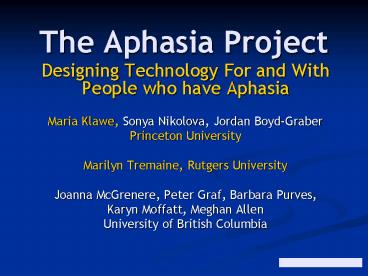The Aphasia Project - PowerPoint PPT Presentation
1 / 35
Title:
The Aphasia Project
Description:
Paper low-fi prototypes. Medium-fi prototypes. I: Participatory ... I: High-fi Prototypes. ESI Planner. NESI Planner. I: Formal Evaluation. 8 participants ... – PowerPoint PPT presentation
Number of Views:42
Avg rating:3.0/5.0
Title: The Aphasia Project
1
The Aphasia Project
- Designing Technology For and With People who have
Aphasia - Maria Klawe, Sonya Nikolova, Jordan Boyd-Graber
- Princeton University
- Marilyn Tremaine, Rutgers University
- Joanna McGrenere, Peter Graf, Barbara Purves,
- Karyn Moffatt, Meghan Allen
- University of British Columbia
2
Outline
- What is Aphasia?
- Problems with existing solutions
- The evolution of ESI planner
- Broader impacts
3
What is Aphasia?
Aphasia is a loss of words not intelligence
lhd have meelk
- Acquired language disorder
- Caused by brain damage (e.g. stroke, trauma, etc.)
- Impairment of communication abilities
- Relative sparing of other cognitive abilities
4
Impact of Aphasia
- More common than Parkinsons disease
- Withdrawal from society
5
Problems with existing solutions
- Limited to communication lack of higher level
applications - Communication too slow for most aphasics
- Stigma of relying on laptops in public
- Poor user-interface of handhelds
- Buttons too small
- Confusing navigation
- Poor organization of multi-media data
6
The Aphasia Project
- Goal understand how individuals with aphasia
communicate and seek opportunities where
technology can better support individuals in
their daily life - Interdisciplinary project computer science,
psychology, speech language pathology - Multi-site UBC, Princeton, aphasia centers,
7
Types of Subprojects
- I Participatory design of application prototypes
- Daily planner
- Handheld
- Combined handheld and laptop system
- Recipe book (laptop or tablet)
- File system (handheld)
- II Evaluation of commercial PDAs
- Long term use by Skip
- Short term use of camera function
8
Special challenges with research involving
aphasics
- Access to participants
- Communication with participants
- Right hemiparesis
- Lack of experience with computers, PDA
- Uncertain future of PDAs
9
I Participatory Design of High-Level Application
Prototypes
- daily planner
- interactive cookbook
- Anita Borg,
- 1949 - 2003
Karyn Moffatt
10
ESI Planner 1
The Enhanced with Sound and Images Planner
- PDA application (iPaq from HP)
- A computerized daily planner designed for people
with aphasia - Uses images, sound, and text to represent people
and places in appointments
11
I Images, Sound, Text
- Say you have an appointment with Queen Elizabeth,
at the Eiffel Tower on November 6, 2003 from
800am to 1000am - ESI Planner would display it like this
12
I Participatory Design
- Four phases
13
I Participatory Design
- Four phases
- Idea brainstorming
- Interviews
- Identified needs
- Daily planner
- Recipe book
?
?
?
14
I Participatory Design
- Four phases
- Idea brainstorming
- Paper low-fi prototypes
2 - Using computer tools
1 - Drawn by hand
15
I Participatory Design
- Four phases
- Idea brainstorming
- Paper low-fi prototypes
- Medium-fi prototypes
16
I Participatory Design
- Four phases
- Idea brainstorming
- Paper low-fi prototypes
- Medium-fi prototypes
- High-fi prototypes and formal evaluation in lab
17
I High-fi Prototypes
ESI Planner
NESI Planner
18
I Formal Evaluation
- 8 participants
- Session 1
- 30 minutes with each Planner (ESI and NESI)
- 10 tasks (retrieval, creation, modification)
- of tasks completed
- of tasks completed correctly
- Session 2 Western Aphasia Battery
19
I Results
Significantly more tasks completed correctly with
ESI Planner.
- Preference 5 ESI, 3 NESI.
20
Limitations of ESI Planner 1
- Need for field study
- Interface for input and modification of
appointments - Lack of stable memory on iPAQ after power loss
- Lack of library of icons and sounds
21
ESI Planner 2
- Input on laptop
- Lingraphica library of icons and sounds
- Stable memory
- Built-in camera in iPAQ
- Participatory design with speech language
pathologists (SLPs) - Four week field study
22
Lingraphica
- Current Lingraphica system
- Laptop-based (easier interface)
- Used at home for practice
- Issues
- Expensive, restricted to AAC insurance diagnosis
- Stigma
23
A Lingraphica phrase
24
Initial goal for prototype
- Download appointments and phrases from
Lingraphica to ESI planner on handheld - Anticipated uses
- Visits to doctors, etc.
- Shopping
- Medication
25
ESI Planner 2 home
26
appointments
27
phrase
28
The need for LgLite
- Lingraphica (Lg) too complex
- Inability to add photos in Lg
- No Windows version of Lg
29
LgLite interface
30
LgLite interface
31
The Pilot Field Study
- Seven aphasics at Adler Aphasia Center
- Four weeks, one videotaped meeting with each
participant per week - Log of interactions with iPAQ and computer
32
Outcomes
- Little use of appointments
- Input only possible at Adler Center
- Desire for input on iPAQ
- Extensive use of camera
- Desire for better photo management on iPAQ
- Problems with sound playback
- Range of text and speech abilities
- Enthusiasm for continued use of iPAQs
33
Next steps
- Add input on iPAQ
- Improve photo management on iPAQ
- Improve sound playback
- Improve LgLite interface
- Another field study at Adler
34
Broader impact
- Dual usefulness between aphasics and elderly
(poor vision, memory loss, Alzheimers, etc.) - Other visual language applications
35
For More Info
- http//www.cs.ubc.ca/projects/Aphasia/































